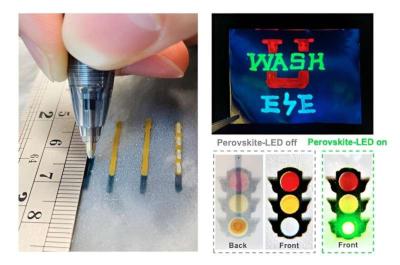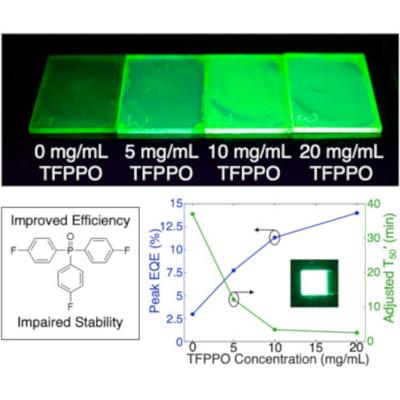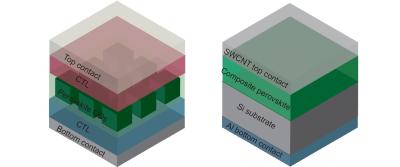What are perovskites?
Perovskite is a calcium titanium oxide mineral, with the chemical formula CaTiO3, discovered in the Ural Mountains of Russia by Gustav Rose in 1839 and named after Russian mineralogist Lev Perovski (1792–1856).
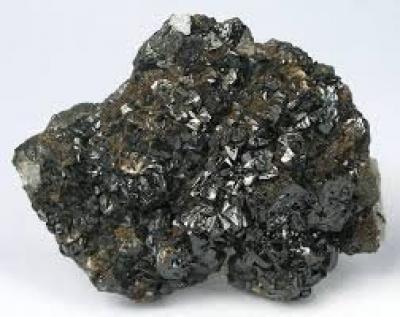
Perovskites are a class of materials with a similar structure that are easily synthesized and relatively low-cost. Perovskites are considered the future of solar cells and are also predicted to play a significant role in next-gen electric vehicle batteries, displays, sensors, lasers and much more.
Perovskites can have an impressive collection of interesting properties including “colossal magnetoresistance” - their electrical resistance changes when they are put in a magnetic field (which can be useful for microelectronics). Some Perovskites are superconductors, which means they can conduct electricity with no resistance at all. Perovskite materials exhibit many other interesting and intriguing properties. Ferroelectricity, charge ordering, spin dependent transport, high thermopower and the interplay of structural, magnetic and transport properties are commonly observed features in this family. Perovskites therefore hold exciting opportunities for physicists, chemists and material scientists.
What are LEDs?
A light-emitting diode (LED) is an electronic component that is essentially a two-lead semiconductor light source. It is a p–n junction diode that emits light upon activation by a voltage applied to the leads, which makes electrons recombine with electron holes within the device, releasing energy in the form of photons. This effect is called electroluminescence, and the color of the light is determined by the energy band gap of the chosen semiconductor.
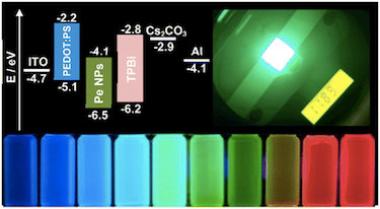
LEDs’ advantages over incandescent light sources include lower energy consumption, longer lifetime, improved physical robustness, smaller size, and faster switching. Light-emitting diodes have become ubiquitous and are found in diverse applications in the aerospace and automotive industries, as well as in advertising, traffic signals, camera flashes and much more.
LEDs meant for general room lighting currently remain more expensive than fluorescent or incandescent sources of similar output, but are significantly more energy efficient.
What can perovskites do for LEDs?
Current high-quality LEDs are based on direct bandgap semiconductors, but making these devices is no easy task because they need to be processed at high temperatures and in vacuum, which makes them rather expensive to produce in large quantities. Perovskites that are direct-bandgap semiconductors could be real alternatives to other types of direct-bandgap materials for applications like color displays, since they are cheap and easy to make and can be easily tuned to emit light of a variety of colors.
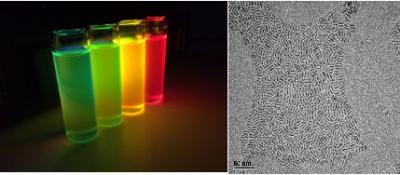
Researchers have found that organometal halide-based perovskites (a combination of lead, organics and halogens that arrange into perovskite crystal structure in the solid state) could be very suitable for making optoelectronics devices, since they can be processed in solution and do not need to be heated to high temperatures. This means that large-area films of these materials can be deposited onto a wide range of flexible or rigid substrates. The perovskites also have an optical bandgap that can be tuned in the visible to infrared regions, which makes them very promising for a range of optoelectronics applications. These materials also emit light very strongly, which makes them very suitable for making LEDs. The light emitted by the perovskites can be easily tuned, which could make them ideal for color displays and lighting, and in optical communication applications.
However, a major obstacle that perovskites will have to overcome in order to be used in LED-type devices is that electrons and holes only weakly bind in perovskite thin films. This means that excitons (electron-hole pairs) spontaneously dissociate into free carriers in the bulk recombination layer, leading to low photoluminescence quantum efficiency (PLQE), high leakage current and low luminous efficiency. This obviously impairs perovskites’ ability to create high-performance LEDs, and for perovskite materials to make a comparable impact in light emission, it is necessary to overcome their slow radiative recombination kinetics. Simply put, researchers will have to find ways of effectively confining electrons and holes in the perovskite so that they can “recombine” to emit light. Major progress is already being made in this field, and it seems that perovskites will indeed open the door to a low-cost, color-tunable approach to LED development.
Recent work in the field of perovskite-based LEDs
In July 2016, researchers at Nanyang Technological University in Singapore have fabricated high-performance green light-emitting diodes based on colloidal organometal perovskite nanoparticles. The devices have a maximum luminous efficiency of 11.49 cd/A, a power efficiency of 7.84 lm/W and an external quantum efficiency of 3.8%. This value is said to be about 3.5 times higher than that of the best colloidal perovskite quantum-dot-based LEDs previously made.
In March 2016, researchers at the University of Toronto in Canada and ShangaiTech University in China have succeeded in using colloidal quantum dots in a high-mobility perovskite matrix to make a near-infrared (NIR) light-emitting diode (LED) with a record electroluminescence power conversion efficiency of nearly 5% for this type of device. The NIR LED could find use in applications such as night vision devices, biomedical imaging, optical communications and computing.
In February 2016, researchers from the Universitat Jaume I and the Universitat de València have studied the interaction of two materials, halide perovskite and quantum dots, revealing significant potential for the development of advanced LEDs and more efficient solar cells. The researchers quantified the "exciplex state" resulting from the coupling of halide perovskites and colloidal quantum dots, both known separately for their optoelectronic properties, but when combined, these materials yield longer wavelengths than can be achieved by either material alone, plus easy tuning properties that together have the potential to introduce important changes in LED and solar technologies.
In December 2015, researchers at Pohang University in Korea are reportedly the first to develop a perovskite light emitting diode (PeLED) that could replace organic LED (OLED) and quantum dot LED (QDLED).
Organic/inorganic hybrid perovskite have much higher color-purity at a lower cost compared to organic emitters and inorganic QD emitters. However, LEDs based on perovskite had previously shown a limited luminous efficiency, mainly due to significant exciton (a complex of an electron and hole that can allow light emission when it is radiatively recombined) dissociation in perovskite layers. The research team overcame the efficiency limitations of PeLED and boosted its efficiency to a level similar to that of phosphorescent OLEDs. This increase was attributed to fine stoichiometric tuning that prevents exciton dissociation, and to nanograin engineering that reduces perovskite grain size, and concomitantly decreases exciton diffusion length. PeLED might be a game changer in the display and solid-state lighting industries, with significantly improved efficiency as well as advantages like excellent color gamut and low material cost.
In November 2015, Florida State researchers have developed a cheaper, more efficient LED, or light-emitting diode, using perovskites. The researchers spent months using synthetic chemistry to fine-tune the materials in the lab, creating a perovskite material capable of emitting a staggering 10,000 candelas per square meter when powered by 12 volts. The scientists say that such exceptional brightness owes, to a large extent, to the inherent high luminescent efficiency of this surface-treated, highly crystalline nanomaterial.
The latest perovskite LED news:
Researchers examine the role of chloride on the instability of blue emitting mixed-halide perovskites
Researchers in Sweden and China have studied the reasons behind the short operational lifetime of blue perovskite-based LEDs (PeLEDs).
While perovskite light-emitting diodes (PeLEDs) have seen unprecedented development in device efficiency over the past decade, they still suffer from poor operational stability. This is especially true for blue PeLEDs, whose operational lifetime remains orders of magnitude behind their green and red counterparts. The scientists in this work have systematically investigated this efficiency-stability discrepancy in a series of green- to blue-emitting PeLEDs based on mixed Br/Cl-perovskites. Typically, mixed chloride/bromide perovskites are employed to produce ideal blue emission. However, the researchers have uncovered a counterintuitive fact: even minute quantities of chloride loading can have a dramatic negative impact on the operational lifetime of these devices.
Researchers use perovskites to develop “multielement ink” – a “high-entropy” semiconductor that can be processed at low-temperature or room temperature
Researchers from Lawrence Berkeley National Laboratory (Berkeley Lab) and UC Berkeley have developed room-temperature-solution (20 °C) and low-temperature-solution (80 °C) synthesis procedures for a new class of metal halide perovskite high-entropy semiconductor (HES) single crystals. The “multielement ink” could enable cost-effective and energy-efficient semiconductor manufacturing and accelerate the sustainable production of next-gen microelectronics, photovoltaics, solid state lighting, and display devices.
“The traditional way of making semiconductor devices is energy-intensive and one of the major sources of carbon emissions,” said Peidong Yang, the senior author on the study, a faculty senior scientist in Berkeley Lab’s Materials Sciences Division and professor of chemistry and materials science and engineering at UC Berkeley. “Our new method of making semiconductors could pave the way for a more sustainable semiconductor industry.”
Researchers report self-assembled monolayer–based blue perovskite LEDs
Researchers from the University of Toronto, Peking University and Soochow University have studied the origins of unwanted emission in monolayer perovskite LEDs when the active layer thickness approaches ~5 nm and found that using available fabrication techniques results in a rough perovskite/HTL interface which leads to punch-through and direct electrical interaction between HTL and ETL (electron-transporting layer), and consequently, to undesired exciplex emission in LEDs.
The team sought to control monolayer interfaces in Rec.2100 primary blue perovskite LEDs and recognized that a well-defined, ordered, and compact monolayer film could suppress HTL/ETL interaction. They reasoned that this could be achieved if they could alter the polarity of the CsPbBr3 c-NC surface and thereby induce perovskite self-assembly down to the monolayer limit [i.e., self-assembled monolayer (SAM)] through the use of an HTL-compatible ligand. Self-assembled films with ordered nanocrystal arrangement maximize the interactions between nanocrystals and provide homogeneity needed for monolayer films with ~5-nm thickness.
Researchers design novel quantum random number generation based on a perovskite light emitting diode
Researchers from Linköping University in Sweden and Universidad de Concepción in Chile recently designed a new type of random number generator for encryption, based on Perovskiye LEDs. The new technology could make digital information exchange safer, cheaper and more environmentally friendly and even pave the way for a new type of quantum communication.
To encrypt information, a random number generator is used, which can either be a computer program or the hardware itself. The random number generator provides keys that are used to both encrypt and unlock the information at the receiving end. Different types of random number generators provide different levels of randomness and thus security. Hardware is the safer option as randomness is controlled by physical processes. And the hardware method that provides the best randomness is based on quantum phenomena – what researchers call the Quantum Random Number Generator, QRNG.
Researchers develop ballpoint pens that can write perovskite LEDs on diverse substrates
Researchers from Washington University in St. Louis and Florida State University have developed a versatile, scalable and eco-friendly handwriting approach to draw multicolor perovskite light-emitting diodes and perovskite photodetectors on various substrates, including paper, textiles, plastics, elastomers, rubber and three-dimensional objects.
The team's method uses common ballpoint pens filled with newly formulated inks of conductive polymers, metal nanowires and multiple perovskites for a wide range of emission colors. Just like writing with multicolored pens, writing layer-by-layer with these functional inks enables perovskite optoelectronic devices to be realized within minutes.
Researchers explore the effects of a molecular additive for perovskite LEDs
Researchers from Stanford University and Mississippi State University recently explored the potential of Mn2+-doped perovskite LEDs (PeLEDs) for lighting and display applications.
By introducing a molecular additive, tris(4-fluorphenyl)phosphine oxide (TFPPO), Mn2+-doped PeLEDs achieved a peak external quantum efficiency of 14.0% and peak luminance (i.e., brightness) of 128,000 cd/m2. These high efficiencies and brightnesses suggest that Mn2+-doped PeLEDs could be implemented in lighting or display applications. However, device stability is also important to consider. The team found that introducing TFPPO compromises the stability of Mn2+-doped PeLEDs—a decrease from 37.0 to 2.54 min. By analyzing both the optoelectronic and photophysical characteristics of Mn2+-doped PeLEDs before and after device operation, the scientists reported insights into this efficiency-stability trade-off.
Researchers use perovskites to design LEDs that reveal rot in food before it is visible
Researchers at the Indian Institute of Science Education and Research (IISER) have developed new LEDs which emit light simultaneously in two different wavelength ranges, for a simpler and more comprehensive way to monitor the freshness of fruit and vegetables.
The team explains that modifying the LEDs with perovskite materials causes them to emit in both the near-infrared range and the visible range, a significant development in the contact-free monitoring of food. Angshuman Nag and his team at the Indian Institute of Science Education and Research (IISER) are proposing a perovskite application in LED technology that could simplify the quality control of fresh fruit and vegetables.
Researchers develop perovskite LEDs with an external quantum efficiency exceeding 30%
Researchers from Xiamen University and China Jiliang University have reported ultrahigh-efficiency green PeLEDs with quantum efficiencies surpassing a milestone of 30% by regulating the charge carrier transport and near-field light distribution to reduce electron leakage and achieve a high light outcoupling efficiency of 41.82%.
The scientists applies Ni0.9Mg0.1Ox films with a high refractive index and increased hole carrier mobility as the hole injection layer to balance the charge carrier injection and insert the polyethylene glycol layer between the hole transport layer and the perovskite emissive layer to block the electron leakage and reduce the photon loss.
Stanford team shows how water additives improve the efficiency of violet perovskite light-emitting diodes
Researchers from Stanford University have reported a novel way to improve the performance of perovskite light-emitting diodes (PeLEDs) in the violet region. The new method could represent a promising step toward cost-effective and efficient ultraviolet PeLEDs.
By engineering the crystallization process of spin-coated 2D perovskites with water, the resulting PeLEDs exhibit bright violet emission at 408 nm with an external quantum efficiency of 0.41%, a 5-fold increase over control devices.
Researchers design ITO-free silicon-integrated perovskite electrochemical cell for light-emission and light-detection
Researchers from Russia's Alferov University, ITMO University, Far Eastern Branch of Russian Academy of Sciences, Peter the Great St. Petersburg Polytechnic University, Skolkovo Institute of Science and Technology and China's Qingdao Innovation and Development Center have developed a novel design for a perovskite electrochemical cell for light-emission and light-detection, where the active layer consists of a composite material made of halide perovskite microcrystals, polymer support matrix, and added mobile ions.
Schematic diagrams of (a) the typical PeLED device structure, where CTL - charge transfer layer, QD - quantum dots and (b) the team's PeLEC device structure, where SWCNT - single-walled carbon nanotubes. Image from Opto-Electronic Advances.
The team explained that while halide perovskite light-emitting devices exhibit exceptional properties such as high efficiency, high color purity, and broad color gamut, their industrial integration generally suffers from the technological complexity of devices' multilayer structure alongside in-operation induced heating poor stability. Halide perovskite light-emitting electrochemical cells are a novel type of perovskite optoelectronic device that differs from the perovskite light-emitting diodes by a simple monolayered architecture.
Pagination
- Previous page
- Page 2
- Next page
